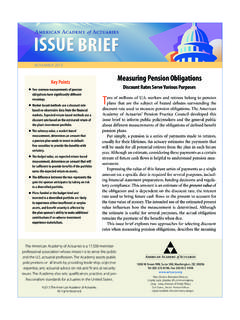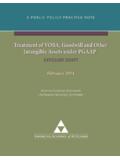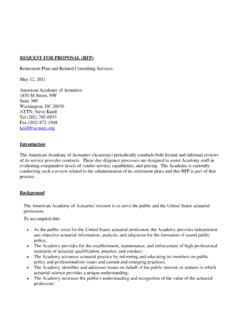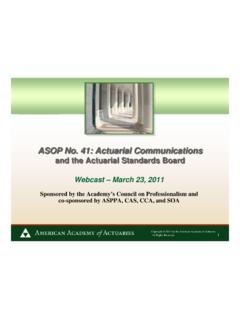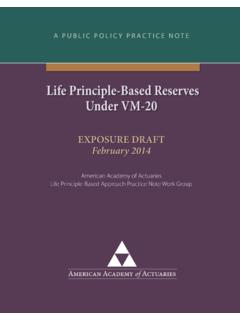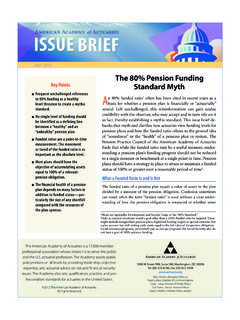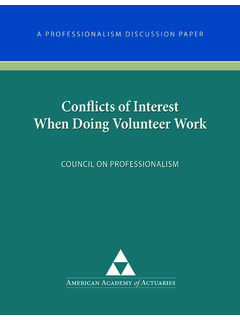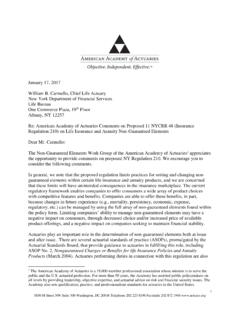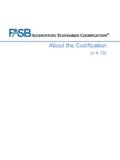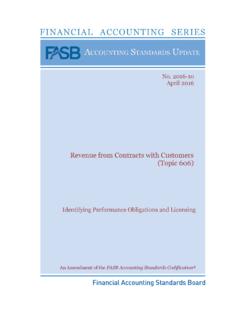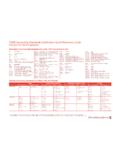Transcription of GAAP Accounting for Profits Followed by Losses in Long ...
1 gaap Accounting for Profits Followed by Losses in Long-Duration Contracts A PUBLIC POLICY PRACTICE NOTEJune 2015 Developed by the Profits Followed By Losses Subgroup of the Financial Reporting Committee of the American Academy of ActuariesA PUBLIC POLICY PRACTICE NOTE gaap Accounting for Profits Followed by Losses in Long-Duration Contracts June 2015 Developed by the Profits Followed By Losses Subgroup of the Financial Reporting Committee of the American Academy of Actuaries The American Academy of Actuaries is an 18,500+ member professional association whose mission is to serve the public and the actuarial profession. The Academy assists public policymakers on all levels by providing leadership, objective expertise, and actuarial advice on risk and financial security issues.
2 The Academy also sets qualification, practice, and professionalism standards for actuaries in the United States. Practice Note on gaap Accounting for Profits Followed by Losses in Long-Duration Contracts 2015 American Academy of Actuaries 2 2014-15 Profits Followed By Losses Subgroup Robert G. Frasca, MAAA, FSA Chairperson Charles K. Chacosky, MAAA, FSA John Pierce, MAAA, FCAS, FCA William Obert, MAAA, FSA Leonard Reback, MAAA, FSA Special thanks to those who helped finalize the practice note: Stephen DiCenso, MAAA, FCAS; Noel Harewood, MAAA, FSA; and Laurel Kastrup, MAAA, FSA.
3 1850 M Street , Suite 300 Washington, 20036-5805 Practice Note on gaap Accounting for Profits Followed by Losses in Long-Duration Contracts 2015 American Academy of Actuaries 3 This practice note was prepared by the Profits Followed by Losses Subgroup organized by the Financial Reporting Committee within the Risk Management and Financial Reporting Council of the American Academy of Actuaries. This document is intended to provide information to actuaries preparing, reviewing, or commenting on Generally Accepted Accounting Principles ( gaap ) Accounting for Profits Followed by Losses in long-duration contracts, in accordance with the Accounting standards codification (ASC) 944-60-25-9, Long-Duration Contracts (formerly the Statement of Financial Accounting standards (FAS) No.)
4 60 Accounting and Reporting by Insurance Enterprises), and other relevant information. ASC 944-60-25-9 provides guidance on the required criteria, timing, and location for recording long-duration contracts within financial statements. This practice note is intended for use as a reference tool only and is not a substitute for any legal or Accounting analysis or interpretation of the regulations or statutes. This practice note is not a promulgation of the Actuarial standards Board (ASB), is not an actuarial standard of practice, is not binding upon any actuary, and is not a definitive statement as to what constitutes appropriate practice or generally accepted practice in the area under discussion.
5 Events occurring subsequent to this publication of the practice note may make the practices described in this practice note irrelevant or obsolete. This practice note is not an official or comprehensive interpretation of any Accounting guidance, including the ASC 944-60-25-9, Long-Duration Contracts, and FAS 60. Future regulatory and legislative activity may change materially certain information presented in this practice note. We welcome comments and questions. Please send comments to Practice Note on gaap Accounting for Profits Followed by Losses in Long-Duration Contracts 2015 American Academy of Actuaries 4 TABLE OF CONTENTS Introduction.
6 5 Background .. 5 Q1. What are Profits Followed by Losses ? .. 6 Q2. What are Losses in Q1? .. 7 Application and Considerations .. 7 Q3. To what type of contracts does the Profits Followed by Losses Accounting guidance apply?7 Q4. Under what circumstances do Profits Followed by Losses occur? .. 8 Q5. At what level should the test be performed? .. 9 Q6. Should business projected to be written in the future (and not yet in-force as of the current valuation date) be included in the Profits Followed by Losses test? .. 9 Q7. Should future premium rate increases be considered in testing for Profits Followed by Losses ? .. 9 Q8. Should new entrants be projected on group contracts?
7 10 Q9. Should reinsurance ceded be reflected in the analysis of Profits Followed by Losses ? .. 10 Q10. What happens if the test shows Profits Followed by Losses ? .. 11 Q11. How should the liability be increased? .. 11 Q12. What are some methods that could be considered for increasing liabilities to offset future Losses ? .. 11 Q13. What are some considerations around establishing an immediate increase in liabilities? 12 Q14. What are some considerations around accruing an increase in liabilities over time? .. 12 Q15. What are some considerations around adopting a locked-in schedule to establish an additional liability over time? .. 13 Q16. What are some considerations around adopting a dynamic method for funding future Losses over time?
8 13 Q17. Can business written since the prior valuation date (and in-force as of the current valuation date) that meets the company s aggregation criteria be added to the current assessment of Profits Followed by Losses of a block of business that was in force at the prior valuation date? .. 14 Q18. Once a reserve has been accumulated to cover future Losses , how should the additional liability be released into income? .. 15 Q19. How would a locked-in method for releasing the accrued reserve work, and under what circumstances might it be considered? .. 15 Q20. How would a dynamic method for releasing the additional reserve work, and under what circumstances might it be considered?
9 16 Q21. What happens if there is an expectation of Profits Followed by Losses Followed by Profits ?.. 16 Q22. How would one accrue a liability if there is an expectation of Profits Followed by Losses Followed by Profits ? .. 17 Q23. How would one address two (or more) cycles of Profits Followed by Losses within a group of contracts? .. 17 Q24. Are there any special considerations related to participating contracts? .. 18 Q25. Should the change in a liability established in recognition of Profits Followed by Losses be included in estimated gross Profits used as the basis for amortizing the asset for capitalized acquisition costs? .. 18 Q26. How should shadow Accounting be applied?
10 19 Practice Note on gaap Accounting for Profits Followed by Losses in Long-Duration Contracts 2015 American Academy of Actuaries 5 Introduction This practice note is intended to provide actuaries with additional information on how to record long-duration contracts within financial statements when Profits are Followed by Losses under the Financial Accounting standards Board s (FASB) gaap guidelines. Primary source materials referenced in this practice note include: 1. Statement of Financial Accounting standards No. 60 Accounting and Reporting by Insurance Enterprises (June 1982) 2.


